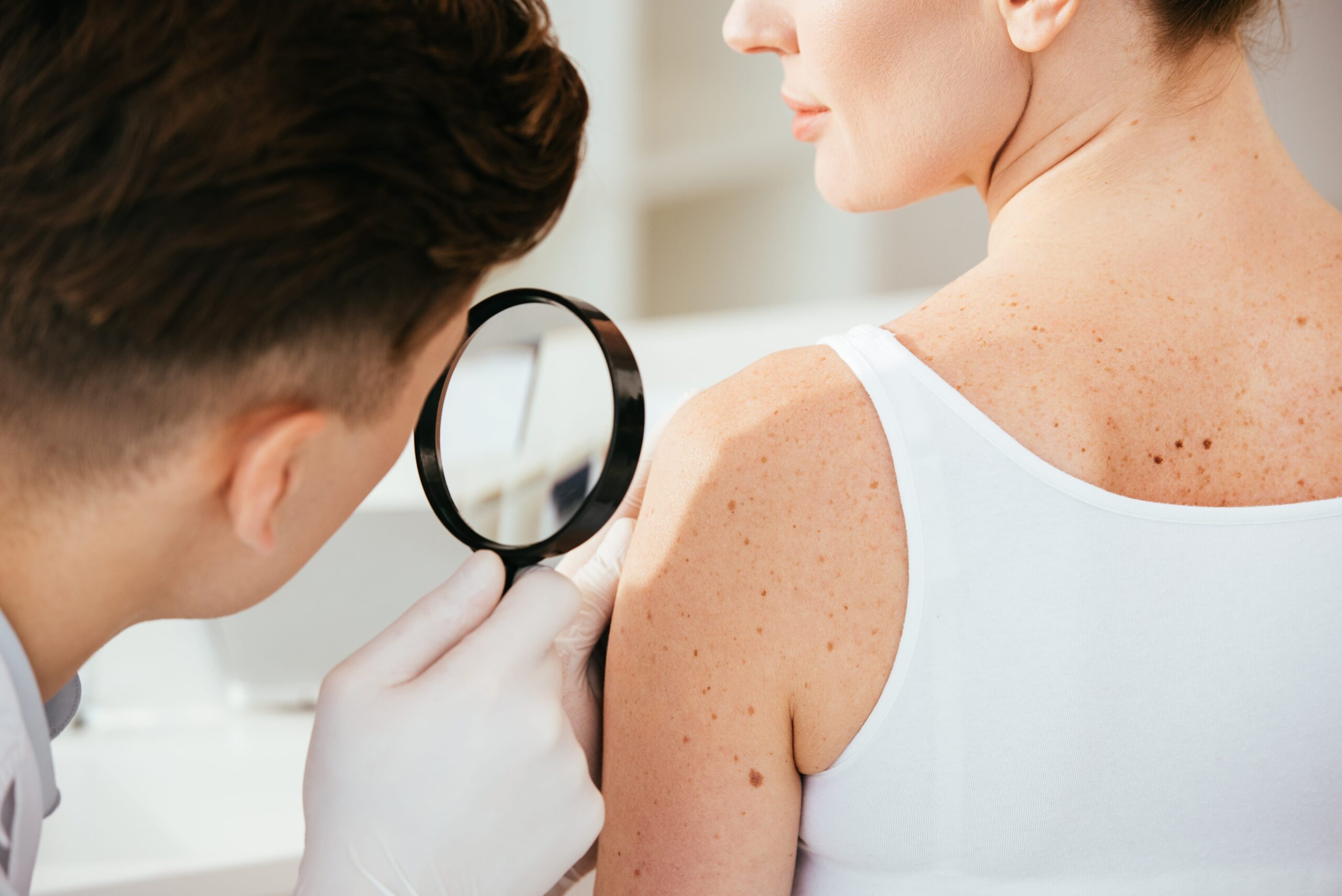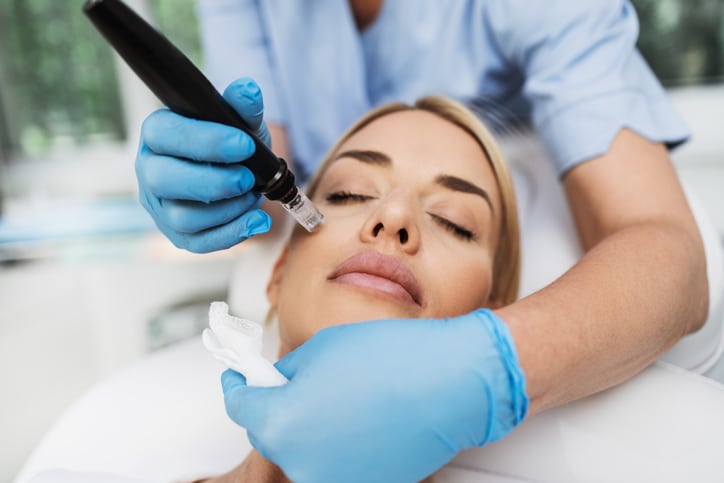When it comes to health, prevention is always better than cure. And this message resonates more profoundly when it comes to skin cancer. Ranked among the most prevalent types of cancer worldwide, the number of people suffering from this destructive illness continues to skyrocket.
Skin cancer is the most common type of cancer worldwide, yet most cases are preventable. The damaging effects of the sun’s ultraviolet (UV) rays and other risk factors, such as tanning and certain genetic predispositions, pave the way for this dangerous disease.
While it’s impossible to eliminate the risk completely, certain precautions can greatly reduce it. Today, we share 5 expert-approved tips to help you keep skin cancer at bay.

All You Need To Know About Skin Cancer
Skin cancer is the uncontrollable growth of abnormal skin cells, usually caused by exposure to the sun’s harmful UV rays. It is crucial to be informed about its types, warning signs, and available treatment options in order to respond effectively to any potential threat.
Skin cancer, whether melanoma, Merkel cell carcinoma, squamous cell carcinoma, or basal cell carcinoma, progresses in distinct stages. Understanding these stages is crucial in your cancer care and in determining your treatment options.
The types of skin cancer, such as squamous cell skin cancer and basal cell carcinoma, typically have five stages (0 to 4). Stage 0, or superficial skin cancer, is confined to the top layer or surface of the skin, while Stage 4 indicates the spread of skin cancer cells to distant parts of the body. Melanoma, a more severe type of skin cancer, may start under the skin surface with a condition called “in situ” before invading deeper.
Warning Signs and Early Detection
Perform regular skin self-examinations using the ABCDE rule to check for any suspicious moles or spots:
- Asymmetry: One-half of the mole doesn’t match the other.
- Border: Irregular, scalloped, or poorly defined border.
- Color: Varying shades of brown, tan, or black; sometimes red, white, or blue.
- Diameter: Larger than 6mm (the size of a pencil eraser), or a change in size.
- Evolving: Changes in color, size, or shape over time.
Keep an eye out for other signs like sores that don’t heal, itchiness, or any change in skin texture. If you notice any irregularities, consult your dermatologist immediately.
The Major Ways To Implement Skin Cancer Treatment
Receiving a skin cancer diagnosis can be life-altering, aside from Mohs Surgery, but what if routine habits could minimize the risk? Dermatologists and health professionals offer five simple yet expert-approved tips designed to lower your risk of developing this ubiquitous disease. These options illustrate the comprehensive range of skin cancer treatment options available to patients.
1. Wear Sunscreen Every Day As A Treatment Option
Using sunscreen is one of the most effective ways to protect your skin from harmful UV rays. Dermatologists recommend using a broad-spectrum sunscreen of at least SPF 30, even on cloudy days.
Here are the significant reasons why everyone should wear sunscreen every day:
- Protects Your Skin From Harmful UV Rays: The depletion of the ozone layer has made it necessary for everyone to use sunscreen. It blocks the harmful UV rays which the thinning layer can no longer keep from reaching the earth’s surface.
- Prevents Premature Aging: Sun damage from UV rays causes skin photoaging, characterized by a leathery look, rough texture, and appearance of fine lines and wrinkles. Daily use of sunscreen protects your skin and helps to prevent the development of signs of aging.
- Lower Risk Of Skin Cancer: One of the most important reasons for wearing sunscreen is to reduce your risk of skin cancer, particularly squamous cell cancer, skin tumor and melanoma, which is known to be very aggressive and can be life-threatening.
- Prevents Sunburn: Repeated sunburn can weaken your skin, subjecting it to bruises. UV rays, over time, can cause peeling, redness, swelling, and itchiness.
- Enhances Health Of The Skin: The essential skin proteins, such as collagen, keratin, and elastin, are protected by sunscreen. These proteins are required for keeping the skin smooth and healthy.
Apply sunscreen generously on all exposed areas and reapply every two hours or after swimming or sweating. Don’t forget areas like the tips of your ears, your neck, and the back of your hands American Academy of Dermatology.

2. Limit Sun Exposure
While sunlight can provide essential Vitamin D and has some mood-enhancing benefits, it is vital to be aware of the potential risks associated with excessive sun exposure.
The intensity of UV rays is typically the highest between 10 a.m. and 4 p.m. Schedule your outdoor activities in the early morning or late afternoon to limit the time spent under the direct sun. Keep an eye on the UV index, which provides information on the daily levels of UV radiation. Whenever you are outdoors, seek shade whenever possible, particularly during the peak UV hours. You can opt for shaded areas such as under trees, umbrellas, or awnings.
Wear loose-fitting, long-sleeved shirts and long pants made of tightly woven fabrics to protect your skin. Opt for dark colors that provide more protection from UV rays than lighter shades. Invest in clothes with Ultraviolet Protection Factor (UPF), which offers superior sun protection.
A hat with a wide brim (at least 3 inches) can offer added protection to your face, head, neck, and shoulders. Avoid hats with holes or open weaves, as they may allow UV rays to penetrate. UV rays can cause damage to your eyes and increase the risk of cataracts and age-related macular degeneration. Wear sunglasses that offer 100% UV protection and ideally have a wrap-around design to minimize the amount of sunlight entering your eyes from the sides.
3. Regular Skin Checks, Especially For Squamous Cell Skin Cancer
Regular skin checks are vital in maintaining optimal skin health. They serve as a proactive approach to the early detection of skin changes and potential issues, including one of the most dangerous forms of skin cancer, melanoma. Here’s why and how you should conduct regular skin checks:
- Early Detection of Skin Cancer: Regular and thorough skin checks help in the early detection of skin cancer. Catching cancer in its initial stages dramatically improves the chances of successful treatment.
- Monitoring Skin Changes: A progressive record of skin checks aids in tracking down any changes or abnormalities in your skin over time. It can help monitor moles or other spots that may change color, size, and shape.
- Preventing Advanced Disease: A delay in diagnosing and treating some skin cancers can result in advanced disease and poorer outcomes. Regular skin checks can help prevent this.
During each step, look for new and existing moles or growths that begin to grow or change significantly. It’s also essential to spot new skin changes or sores that do not heal.
Check your skin regularly for changes, such as new growths, sores that don’t heal, or persistent rough patches. Consult a dermatologist or cancer care specialist if you notice any suspicious signs.
4. Don’t Use Tanning Beds For Skin Cancer Treatment
Indoor tanning beds emit UV rays that can increase your risk of skin cancer. In fact, studies show that people who have ever tanned indoors have a 67% higher risk of developing squamous cell carcinoma and a 29% higher risk of basal cell carcinoma American Academy of Dermatology.
According to experts, here are the reasons why using tanning beds should be avoided:
Using a tanning bed can raise the risk of melanoma, the deadliest form of skin cancer, by 12%. In addition, non-melanoma skin cancer like squamous cell carcinoma and basal cell carcinoma risks also rise with tanning bed usage.
Tanning beds emit ultraviolet radiation, which causes skin damage and can lead to premature skin aging, similar to the effects of prolonged sun exposure. This includes visible signs like wrinkles, fine lines, age spots, and a leathery texture.
UV radiation from tanning beds can cause eye injuries, including damage to the retina (which can lead to macular degeneration), cataracts, and even certain types of eye cancer. Although tanning goggles are provided, they do not completely eliminate the risk of eye damage.
Exposure to UV radiation from tanning beds can impair the proper functioning of the body’s immune system and the skin’s natural defenses, making you more susceptible to infections. Using tanning beds can cause burns, especially on sensitive skin. Repeated usage can lead to severe and painful burns.
5. Eat A Healthy Diet
Eating a healthy diet is essential to maintaining overall health and is particularly crucial for skin health. The nutrients we consume significantly impact our skin’s appearance, function, and ability to fight off external factors.
Incorporating a nutrient-rich, balanced diet can help provide the essential vitamins and minerals necessary for vibrant and healthy skin. Here are some key factors to consider when aiming for a healthy diet that benefits your skin:
1. Consume Antioxidant-Rich Foods
Fruits and vegetables are filled with antioxidants, such as vitamins A, C, and E, which help protect your skin from damage caused by free radicals and environmental factors. These antioxidants aid in skin repair, protect skin elasticity, and can even reduce the appearance of wrinkles. Some antioxidant-rich foods include:
- Berries (blueberries, strawberries, blackberries, etc.)
- Leafy green vegetables (spinach, kale, collard greens)
- Orange and yellow vegetables (carrots, sweet potatoes, bell peppers)
- Citrus fruits (oranges, grapefruits, lemons)
2. Healthy Fats
Healthy fats, particularly omega-3 and omega-6 fatty acids, support healthy skin by maintaining skin elasticity and hydration and reducing inflammation. Foods rich in healthy fats include:
- Fish (salmon, mackerel, sardines)
- Nuts (walnuts, almonds)
- Seeds (flaxseeds, chia seeds)
- Avocados
3. Stay Hydrated
Hydration is essential for maintaining healthy, radiant skin. Water helps flush toxins, maintain skin elasticity, and promote a clear complexion. Aim to drink at least 8 glasses of water daily and consume water-rich fruits and vegetables such as cucumbers, celery, and watermelon.
4. Lean Protein
Protein is critical for cell growth, repair, and immune function. Consuming sufficient lean protein contributes to your skin’s overall health and appearance. Some lean protein options include:
- Chicken and turkey
- Fish and seafood
- Legumes (beans, lentils, chickpeas)
- Dairy products (Greek yogurt, cottage cheese)
5. Limit Refined Sugars and Processed Foods
Consuming excessive amounts of refined sugars and processed foods can lead to inflammation, which is associated with various skin conditions, such as acne, eczema, and premature aging. Limit the intake of such foods and opt for natural sugars found in fruits and vegetables.
While more research is needed to understand the precise link between diet and skin cancer, it’s generally agreed that a healthy, balanced diet can boost your immune system, potentially helping you to fend off cancer-causing cells better. Foods rich in antioxidants (like vegetables and fruits) and omega-3 fatty acids (like fatty fish and walnuts) are particularly recommended.
Regular skin self-examinations can help identify signs of skin cancer early. Look for new or changing moles, growths, or lesions, especially those with uneven coloring, irregular borders, or varying sizes. If you notice any suspicious spots, schedule an appointment with your dermatologist immediately.
While these strategies can substantially reduce your risk of skin cancer, they cannot completely eliminate the threat. Maintaining a healthy lifestyle, including a balanced diet and regular exercise, supports overall wellness.
Remember, your skin is the first line of defense against the environment. It’s high time we gave it the care it deserves.
Stay mindful. Stay healthy. And as always, stay sun-safe.



